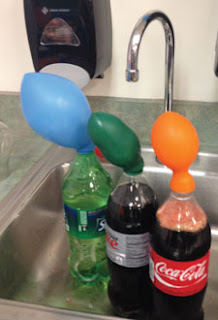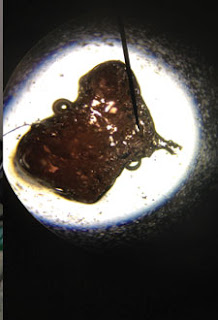
Have you ever heard the rumor that if you eat Pop Rocks and then drink soda, your stomach will explode? Many students have heard this before so we decided to do a little research to see if this was a myth or if it was real. Now, of course we didn’t test our experiment on human or an animal (even though one of my students willingly volunteered to be a test subject). Instead, we used soda and a balloon to represent a human stomach.
First we gathered 3 different types of soda: Coke, Diet Coke, and Sprite. We made sure we used bottles of soda instead of canned soda. Then we filled 3 different balloons with an entire package of Pop Rocks.

Our class made predictions about what they thought would happen. All of the students figured out that we would witness some type of reaction, so I had the students vote on which type of soda they thought would create the biggest reaction.
Then we tested our hypothesis. We chose 1 type of soda to test first. Very carefully (and in the sink... just in case), we placed the opening of the balloon over the mouth of a bottle of soda.



After a few minutes, we noticed the balloon filling up with gas and expanding. Then we did the same to the other 2 types of soda using our remaining balloons.


The students were able to conclude that while consuming Pop Rocks and soda wouldn’t be detrimental to your stomach, it would probably make you pretty gassy.
We concluded the experiment by watching the soda and Pop Rocks candy reaction under a microscope. First we took a small granule of the candy and placed in on the slide. Then we watched through the eyepiece as I used an eyedropper to slowly add soda to the granule.

Here are some pictures of what the reaction looked like.


The purpose of completing this activity was to get the students used to using the Scientific Method. You could also use this to teach about gas, chemical reactions, or carbon dioxide. All in all, this was a wonderful experiment that I will make sure to do with my students every year.
To view more information about this experiment visit http://www.stevespanglerscience.com/experiment/poprocks
For more ideas on how to use candy during experiments (especially your leftover Halloween candy) visit http://www.science20.com/science_motherhood/top_10_scientific_uses_leftover_halloween_candy


No comments:
Post a Comment